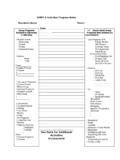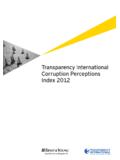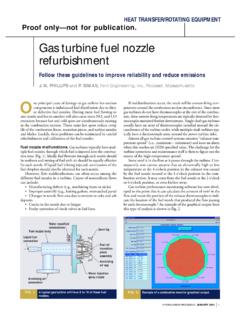Transcription of Key considerations for your internal audit plan
1 Key considerations for your internal audit planEnhancing the risk assessment and addressing emerging risksInsights on governance, risk and complianceMay 2013iiiInsights on governance, risk and compliance | May 2013 Risk assessment leading practices ..2 Accounting ..4 Finance ..6Ta x ..8 Sustainability ..10 Customer ..12 Corporate development ..14 Fraud and corruption ..16 Information security ..18 Business continuity management ..19 Mobile ..20 Cloud ..21IT risk management ..22 Program management ..24 Software/IT asset management ..26 Social media risk management ..28 Segregation of duties/identity and access management ..30 Data loss prevention and privacy ..32 Human resources ..34 Supply chain and operations ..36 Contents 1 Insights on governance, risk and compliance | May 2013 The internal audit risk assessment and the ongoing refresh processes are critical to identifying and filtering the activities that internal audit can perform to provide measurable benefit to the organization.
2 While there are often a number of non-negotiable activities that internal audit functions must support (SOX and other regulatory compliance, external auditor assistance), the internal audit department has the opportunity to deliver increased risk coverage, cost savings and measurable value to the business by identifying and performing audits across the company s value chain. In our role as the leading provider of internal audit services, we have spent considerable time working with our clients and thought leaders to:1. Identify emerging risks and areas that most organizations are currently focused on2. Develop practical audit ideas for these emerging risks3. Consider the questions that chief audit executives should be asking to further qualify their relevanceThe following pages provide a view of where the processes begin by identifying these emerging risks and focus areas and their corresponding practical, value-based audits.
3 This document is intended to facilitate discussion as your organization develops and updates its internal audit activities for the risk radar below depicts the risk by functional area of the business, ranked across the risk management spectrum financial, compliance, operations and strategic. The number associated with each function indicates the page where you can find more information about the emerging risks related to the function, focus areas for internal audit and examples of related audits that deliver value to the Compliance Operations Strategic AccountingFinanceTaxSustainabilityCustom erCorporate developmentFraud and corruptionInformation securitySoftware / IT asset management MobileCloudIT riskmanagement Program managementBusiness continuitymanagement Social media risk management SoD / identity andaccess management Data loss preventionand privacy HumanresourcesSupply chain and operations 682720162314252130262922282310181224 Financial Compliance Operations Strategic AccountingFinanceTaxSustainabilityCustom erCorporate developmentFraud and corruptionInformation securitySoftware/IT asset management MobileCloudIT riskmanagement Program managementBusiness continuitymanagement Social media risk management SoD/identity andaccess
4 Management Data loss preventionand privacy HumanresourcesSupply chain and operations 4628181421122419342632203036 8161022 Source: Ernst & Young, 2013 Recommended readingBusiness Pulse: exploring dual perspectives on the top 10 risks and opportunities in 2013 and beyondGlobal on governance, risk and compliance | May 2013 Components of the risk assessmentBasicDegree of confidenceLow HighLeadingData reviewed internal audit issues SOX and external audit issues Root causes Competitor and peer risks Industry trends Third-party external risk data Analyst reportsData analytics Analytics run but limited summarization of data Business and IA leadership struggle to spot trends in data Risk analytics are based on most critical questions business and IA need to answer Trending and period-to-period comparisons can identify emerging risks or changes to existing risks Efforts are aligned with other big data initiativesStakeholder engagement Focus on Finance/Accounting/IT stakeholders Heavy emphasis on home office stakeholders Point-in-time engagement
5 Primarily during annual risk assessment Business leaders are not trained on risk management Includes operational and global stakeholders beyond Finance/Accounting/IT Risk management is embedded in leadership training Risk scenario planning workshops Continuous dialogue with stakeholders (monthly, quarterly meetings) Risk committee utilized to review risk assessment changesInterview/survey techniques Inconsistent documentation of interviews Surveys used for SOX 302 certification purposes or not at all Subject matter resources participate in select interviews to draw out key risks Surveys used to confirm risk assessment results with lower-level management not interviewed Stakeholders self-assess risk based on GRC solution containing dynamic risk databaseCollaboration internal audit attends interviews with little participation from other risk management functions Risk assessment viewed as internal audit s risk assessment Risk assessment collaboratively developed by internal audit and other risk management functions SOX.
6 External audit and other risk management functions participate in interviews Risk assessment embedded within strategic planning processAudit prioritization Impact and likelihood utilized for prioritization Audits prioritization based heavily on competencies available in IA department Relevance to strategic objectives is utilized to prioritize risks Audits executed based on value to organization and connection to strategic objectivesOutputs Relatively static internal audit plan Dynamic internal audit plan (3+9) SOX plan External audit plan and IA reliance strategy Legal/ethical compliance training plans Business risk mitigation plans (where appropriate)Why is the need for a world-class internal audit risk assessment more vital than ever?There are multiple drivers behind the growing importance of executing a robust and comprehensive risk assessment: internal audit executives continue to be challenged by the audit Committee and executive management to look around the corner and answer the question, Have we identified all the big risks?
7 Changes in the marketplace and external environment: Increased risk due to expanding operations in emerging markets and developing countries Increased regulatory demands Increased focus on cost savings across all functions including internal auditChanges in the role of internal audit within organizations: Effective use of internal audit resources no longer means only maintaining a world-class assurance program that keeps the organization out of trouble. The department must also improve the business through value-based audits and recommendations. Investors are willing to pay for it 82% of institutional investors are more willing to pay a premium for effective risk management (source: Ernst & Young survey)Risk assessment leading practicesWhen assessing risk to the organization, internal audit functions typically fall between basic and leading on the maturity curve below.
8 As your department moves toward leading by utilizing the techniques listed here, you increase your ability to look around the corner and identify the right on governance, risk and compliance | May 2013 Components of the risk assessmentBasicDegree of confidenceLow HighLeadingData reviewed internal audit issues SOX and external audit issues Root causes Competitor and peer risks Industry trends Third-party external risk data Analyst reportsData analytics Analytics run but limited summarization of data Business and IA leadership struggle to spot trends in data Risk analytics are based on most critical questions business and IA need to answer Trending and period-to-period comparisons can identify emerging risks or changes to existing risks Efforts are aligned with other big data initiativesStakeholder engagement Focus on Finance/Accounting/IT stakeholders Heavy emphasis on home office stakeholders Point-in-time engagement primarily during annual risk assessment
9 Business leaders are not trained on risk management Includes operational and global stakeholders beyond Finance/Accounting/IT Risk management is embedded in leadership training Risk scenario planning workshops Continuous dialogue with stakeholders (monthly, quarterly meetings) Risk committee utilized to review risk assessment changesInterview/survey techniques Inconsistent documentation of interviews Surveys used for SOX 302 certification purposes or not at all Subject matter resources participate in select interviews to draw out key risks Surveys used to confirm risk assessment results with lower-level management not interviewed Stakeholders self-assess risk based on GRC solution containing dynamic risk databaseCollaboration internal audit attends interviews with little participation from other risk management functions Risk assessment viewed as internal audit s risk assessment Risk assessment collaboratively developed by internal audit and other risk management functions SOX.
10 External audit and other risk management functions participate in interviews Risk assessment embedded within strategic planning processAudit prioritization Impact and likelihood utilized for prioritization Audits prioritization based heavily on competencies available in IA department Relevance to strategic objectives is utilized to prioritize risks Audits executed based on value to organization and connection to strategic objectivesOutputs Relatively static internal audit plan Dynamic internal audit plan (3+9) SOX plan External audit plan and IA reliance strategy Legal/ethical compliance training plans Business risk mitigation plans (where appropriate)What increases confidence in the risk assessment process? Diversity in data, stakeholders and participants leads to greater risk insight. Technology, used in the right way, is a game changer.
















